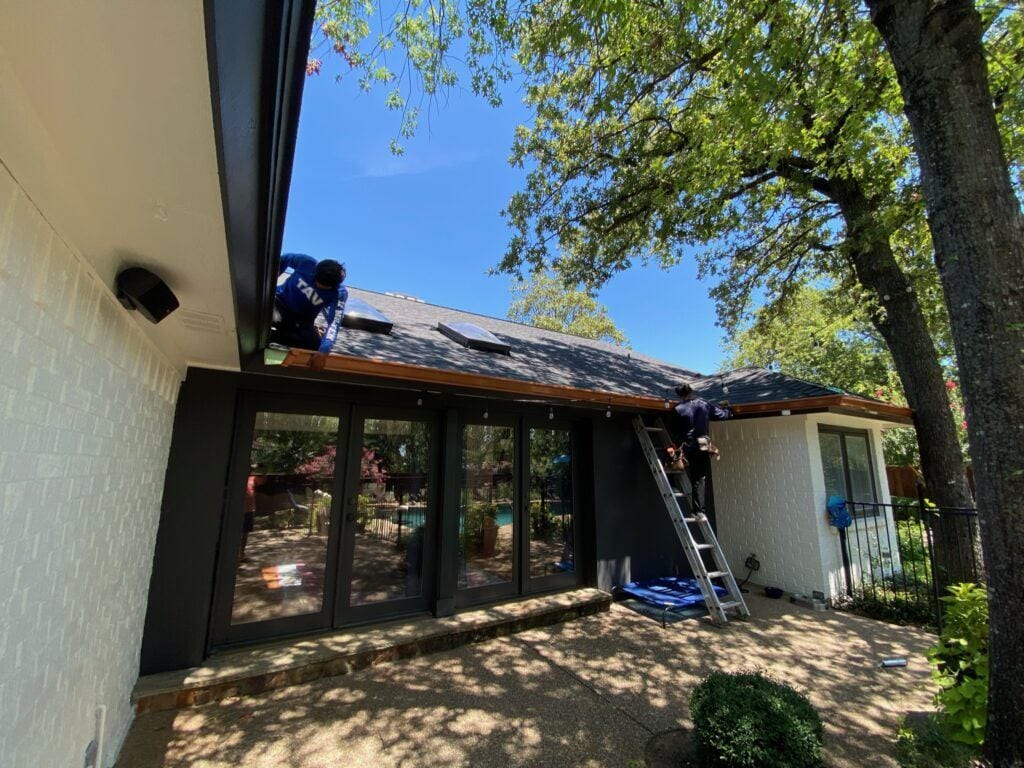A storm can cause severe damage to your property. The roof often takes the brunt of the damage because it’s in direct contact with the storm. In the U.S., storms pose a high risk of damage to your roof. They are a frequent cause of water damage, which can be quite expensive to repair. Knowing “how does storm damage affect my property” can be a game-changer in both preventative maintenance prior to a storm, and how to best handle your roof post-storm.
Your home may find itself in Mother Nature’s path as she goes on a rampage. After the storm, homeowners should have their roofing assessed to determine the extent of the damage. Even seemingly minor damage can worsen over time, leading to more severe and costly damage.
How Storm Damage Occurs
Storm damages may occur due to heavy rain, extreme winds, lightning, and flooding, all of which can destroy your roof and other parts of your home. The storms that commonly cause wind damage are tornadoes and hurricanes. Still, high winds in a thunderstorm may cause damage.
Besides causing damage through direct impact with your roof, strong winds may blow around debris. Extreme winds can yank off your roof’s shingles, whereas falling debris and hail larger than one inch can break or dent roofing. Likewise, heavy rains can lead to the pooling of water, which can cause leaks or worsen them.
In the wake of a storm, it’s advisable to have a professional carry out an inspection to assess the damage and do the necessary repairs. In the case of your roof, this is the work of a professional roofer. Having the necessary repairs done promptly can save you burdensome repairs down the line.
How Does Storm Damage Affect My Roof?
How Damage From a Wind Affects Your Roof
If high winds break or rip off shingles, it leaves your roof susceptible to leaks that can cause severe water damage if they’re not repaired. In some cases, storms rip off an entire roof. Now, it’s easy to think that the sheer impact of extreme winds blew off the roof, but that’s rarely the case. In reality, the culprit is a difference in air pressure below and above the roof.

Air moving at high speeds above the roof causes the pressure of the air above the roof to be lower than the air pressure below the roof (i.e., inside the house). This difference in air pressure creates a lift that pulls the roof outward toward the low-pressure zone. The same principle is behind how an aircraft’s wings lift it up. However, in the case of a roof, the lift pulls off the house. This pressure difference may also cause windows to burst as it pulls the glass outward.
How To Prevent Your Shingles or Entire Roof From Blowing Off
You can take steps to minimize the likelihood that a storm will rip off your roof. Shingles that are in good condition are resilient against high winds that damaged shingles. Scheduled roofing inspections ensure that all the shingles are in their best shape in case a storm comes your way.
Among the signs of damage that roofers check for on asphalt shingles is the loss of granules. Curling around a shingle’s edges is also an indication that it’s damaged. Replacement is due if the shingles have sustained damage from falling debris or hail. Doing so increases the chances that your roof weathers the storm.
In addition to repairing damaged roofing, you can also install high-quality shingles that have a high wind rating to prevent wind damage. While shopping around for shingles, consider your geographical location’s peak and average wind speeds. For example, a wind rating of 100 means that the shingle can withstand wind speeds of up to 100 mph. Installing top-tier shingles can save you hundreds of dollars in future repairs.
How Damage From a Hailstorm Affects Your Roof

Hail larger than one inch can damage most roofing materials. Shingles damaged from hail usually look like they have small dimples or pockmarks. Hail can also chip tiles or shingles around the edges.
The amount of damage depends on the duration of the hailstorm. A short burst of hail larger than one inch may cause slight damage, whereas a sustained hailstorm can result in damage so severe that the entire roof may need replacement.
Metal roofs tend to fare better than other roofing materials. But if the hail is large enough, it can dent softer metal roofing materials, such as copper. The most common type of metal roofing material is steel that has a zinc or zinc alloy coating to prevent rusting. A large enough hail can pierce through this coating, causing the metal roof to rust and eventually leak.
After a severe hailstorm, it’s advisable to have your metal roof inspected to assess the extent of the damage. Professional roofers assess metal roofing after the storm to determine whether this has occurred.
How Professionals Perform a Roofing Inspection
Here are a few things your roofer check for during the roofing inspection:
- Signs of Damage Visible From the Ground. They’ll check to see if any shingles are missing. For metal roofing, the roofer checks for missing or peeling metal flashing in valleys or around chimneys. They’ll check for damage to protrusions such as exhaust piping and vents.
- Signs of Hail Damage. After a hailstorm, roofers check for any dimples or dents in shingles. They’ll also check to see if the hail chipped the edges of the shingles.
- Leaks Inside Your Home. Your roofer will check the attic for any leaks. They’ll also check for any leaks or water spots on the walls or ceilings, which is usually a sign of roof damage.
Safety is of the utmost importance during a roofing inspection, which is why it’s best left to professionals who have the necessary safety equipment and are fully covered in case they become injured or damage the roof in case they slip or fall.
Protect Your Home Against Storm Damage
Some degree of roof damage is inevitable if you live in an area with frequent storms. Following the tips in this article can help you minimize your roof repair costs. Contact Triton Roofing & Restoration today to schedule an inspection and find out how to limit the effects of storm damage on your property.

